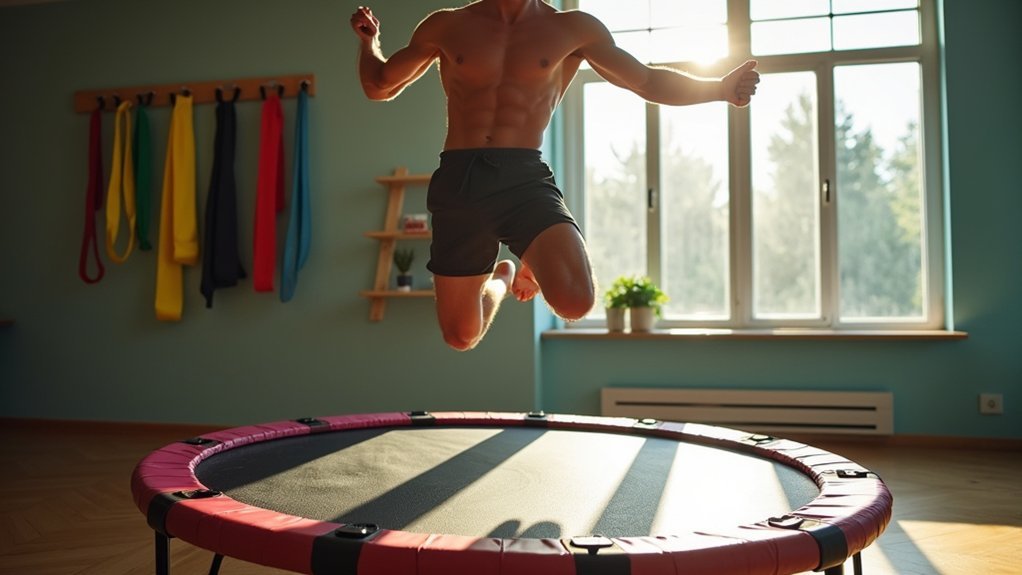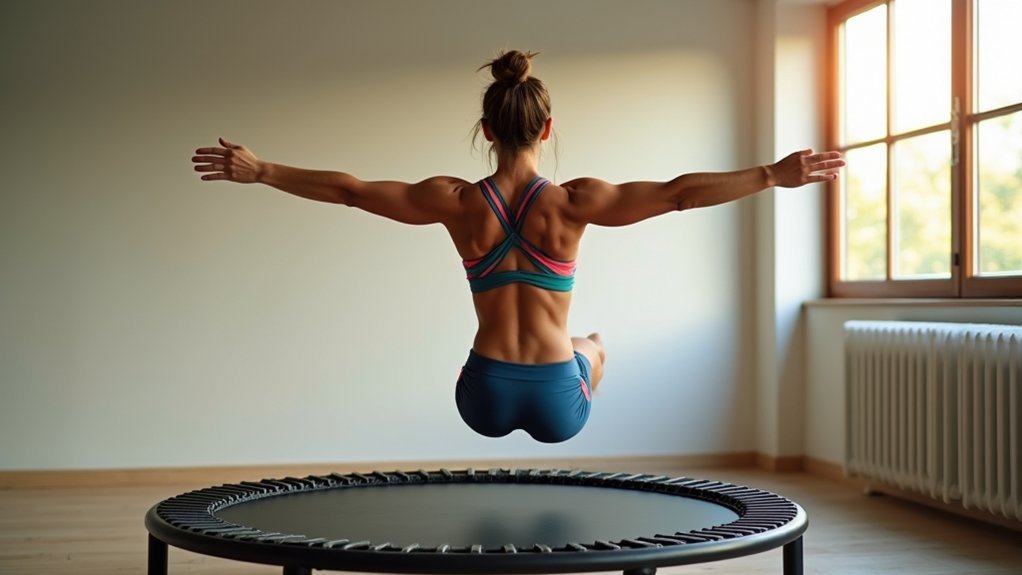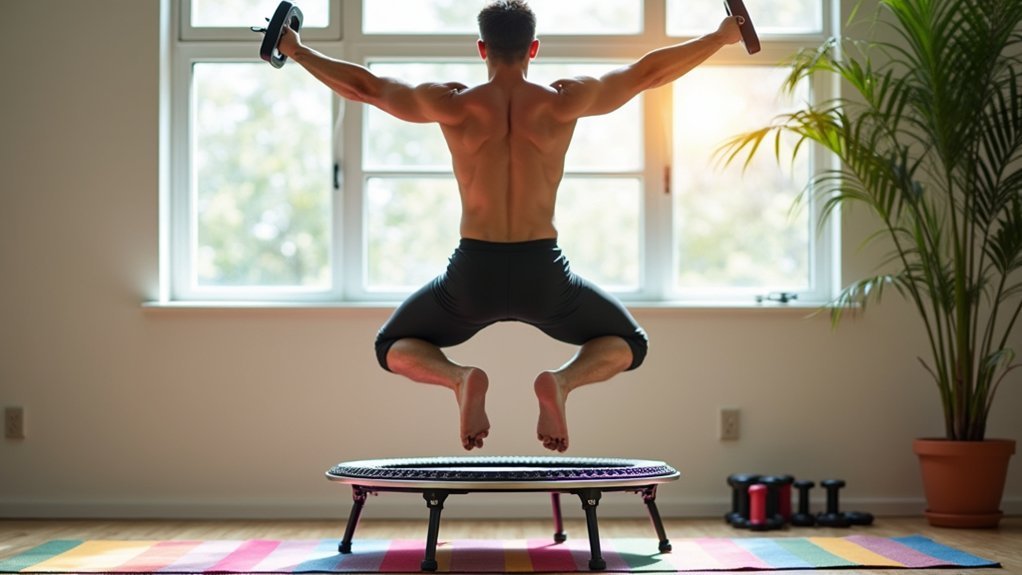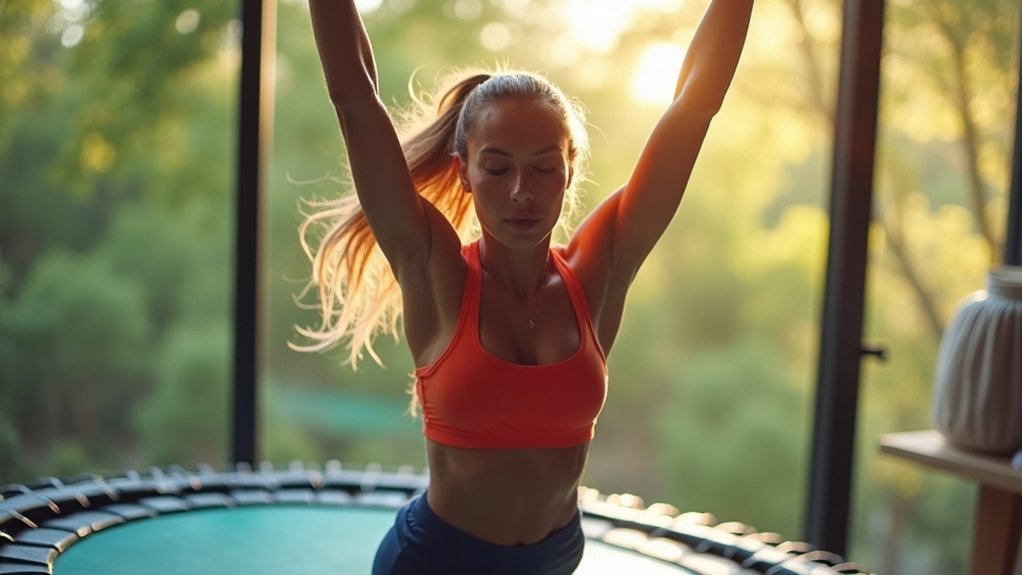Rebounding offers excellent upper body workouts through rhythmic punching patterns, arm circles, and overhead presses that engage your arms and shoulders. You can amplify results with light weights (1-3 pounds) for bicep curls, chest flys, and shoulder presses while bouncing. These movements not only build muscle endurance but also boost lymphatic circulation up to 15 times normal rates, enhancing detoxification and immune function. Discover how this low-impact exercise transforms your upper body with just three 20-minute sessions weekly.
The Science Behind Upper Body Engagement on a Rebounder

While most people associate rebounding with lower body conditioning, the mini-trampoline actually provides remarkable benefits for upper body strength and function.
When you bounce, your muscles work against both gravity and increased G-forces, creating natural resistance for your arms and shoulders.
Rebounding transforms simple movements into powerful resistance training through intensified gravitational forces that challenge your upper body muscles.
Your body responds to the unstable surface by enhancing neuromuscular coordination. Each bounce triggers rapid nerve signaling that improves proprioception and reaction time in your upper limbs.
The rhythmic movements activate more motor units in your deltoids, triceps, and pectorals than standard exercises.
Additionally, rebounding creates unique pressure gradients that accelerate lymphatic flow through your upper body, aiding in toxin removal and potentially boosting immune function in the chest and armpit lymph nodes. This process effectively flushes the lymphatic system while strengthening muscles simultaneously.
Top Arm-Strengthening Rebounding Movements
You’ll strengthen your arms effectively with opposing arm pushes that create resistance against your own body weight.
Rhythmic punching patterns accelerate your heart rate while targeting your biceps, triceps, and shoulders simultaneously. Incorporate small and large arm circles to thoroughly engage shoulder muscles while maintaining a strong core posture.
Try overhead press jumps to engage your entire upper body, as this movement combines explosive lower body power with controlled arm extensions.
Opposing Arm Pushes
Three powerful opposing arm movements form the foundation of effective rebounding arm workouts.
Start with isometric holds by extending your arms in front of you while bouncing, creating resistance as if pushing against an invisible wall. This engages your core and arm muscles simultaneously.
Next, try alternating arm presses by pushing one arm forward while pulling the other back. This rhythmic motion works both arms effectively while improving coordination.
For added intensity, incorporate lateral movements with side-to-side arm swings during your bounce. The tricep reach exercise with full arm extensions can significantly increase upper body muscle activation during rebounding sessions.
For maximum benefit, wear weighted gloves to increase resistance.
Remember to keep your core engaged throughout these exercises to stabilize your body and protect your back.
The low-impact nature of rebounding makes these exercises joint-friendly while still providing significant upper body strengthening and improved blood circulation.
Rhythmic Punching Patterns
Rhythmic punching patterns add a dynamic dimension to your rebounder workout, transforming a simple bouncing session into a full upper body challenge. These movements simultaneously build arm strength, improve shoulder mobility, and enhance your cardiovascular fitness. Choreographed routines often incorporate punching movements as the rhythmic focus helps clear the mind of distractions while exercising.
| Punch Pattern | Benefits |
|---|---|
| Jab-Cross Hooks | Improves coordination and engages shoulders |
| Alternating Punches | Builds bilateral strength and endurance |
| Rotational Punches | Activates core muscles and improves torso flexibility |
| High-Low Punches | Targets varied muscle groups in arms and shoulders |
| Quick Succession Punches | Enhances reaction time and cardiovascular output |
Always warm up your shoulders before starting and maintain proper form throughout. Sync your punches with your rebounds for maximum effectiveness. As you progress, increase your speed and vary your patterns to continually challenge your upper body.
Overhead Press Jumps
Elevate your rebounding workout with overhead press jumps, a dynamic exercise that transforms simple bouncing into a powerful upper body sculptor.
Stand with feet shoulder-width apart, engaging your core while maintaining proper posture throughout the movement. As you jump, drive your arms forward, then press them overhead at the peak of your ascent. Remember to focus on pushing down into the trampoline rather than bouncing upward for maximum muscle engagement.
This motion not only strengthens your shoulders and arms but greatly boosts your cardiovascular intensity while providing low-impact benefits for your joints.
For maximum effectiveness, focus on your breathing rhythm and maintain core stability. You can increase intensity by jumping higher or faster.
Consider combining these jumps with other exercises like bicep curls or bent-over rows to create a thorough upper body routine that enhances both strength and flexibility.
Chest and Shoulder Exercises for Maximum Results
Working your upper body on a rebounder offers five powerful benefits for your chest and shoulders. Combining exercises like chest jumps and shoulder rolls engages multiple muscle groups simultaneously while protecting your joints from high impact.
Transform your upper body with rebounding workouts that build strength while being gentle on your joints—a true win-win for fitness enthusiasts.
For maximum results, incorporate twist jumps and alternating arm waves to work both areas effectively. You’ll see better progress by varying your routine—try bouncing arm circles one day and quick rotations the next. During your session, focus on lengthening the lats while performing boxing movements like hooks and uppercuts for additional upper body engagement.
Don’t forget to maintain proper form with chin tucks and core engagement throughout each movement. Modify exercises by adjusting speed or adding resistance bands when you’re ready for more challenge.
High-repetition interval training will boost your endurance while strengthening your upper body. For safety, start with lower jumps and gradually increase intensity as your stability improves.
Core-Upper Body Connection During Rebounding

The dynamic interplay between your core and upper body transforms ordinary rebounding into a full kinetic chain workout. Every arm swing and resistance movement requires core stabilization to prevent excessive spinal motion while managing rebound forces.
Your obliques engage during twisting motions, while isometric holds demand core bracing against the trampoline’s instability.
When performing pendulum arm swings synchronized with leg drives, you’re creating reciprocal tension across your anterior chain.
The neuromuscular connection intensifies as rotator cuffs activate in tandem with your transverse abdominis, while latissimus dorsi movements recruit thoracolumbar fascia connected to your core.
For ideal results, vary your rebound height—lower bounces emphasize stabilization while higher ones engage power.
Adding unstable loads with water weights or resistance bands further increases core co-contraction during upper body exercises. Although designed primarily for muscle endurance, not muscle building, adding optional wrist weights of 1-2 pounds can effectively enhance the resistance challenge.
Lymphatic Benefits of Upper Body Rebounding
Rebounding’s impact extends beyond muscle engagement to revolutionize your body’s internal cleansing system. When you add upper body movements to your rebounder routine, you’re amplifying lymphatic flow throughout your entire system. The gravitational changes during each bounce force lymphatic valves to open and close, creating a pumping effect that can increase lymph flow up to 15 times normal rates.
Rebounding transforms your lymphatic system through controlled gravitational changes, creating a detoxification powerhouse with every bounce.
- Arm movements while rebounding specifically target underarm lymph nodes, reducing congestion in a commonly stagnant area.
- Enhanced lymph circulation helps remove toxins and potentially damaged cells more efficiently.
- Your white blood cell count may triple during rebounding, boosting immune function.
- Combining upper and lower body movements creates a whole-body lymphatic flush that helps combat fatigue and supports detoxification.
The gentle bouncing motion provides complete cellular exercise that sedentary individuals especially need to combat poor lymphatic flow and reduce illness risk.
Incorporating Weights for Enhanced Upper Body Toning

Adding weights to your rebounder routine dramatically amplifies the upper body toning benefits you’ll experience during each session.
Try chest flys and skull crushers while lying on the rebounder with your legs elevated, using dumbbells to increase resistance.
For standing exercises, perform bicep curls and bent-over rows while balancing on the bouncy surface to engage your core simultaneously.
Kneeling positions work well for hammer curls, shoulder presses, and lateral raises, adding an extra stability challenge.
The unstable surface of the rebounder automatically activates your core muscles during all upper body movements, creating a more effective full-body workout.
Adjust your dumbbell weight based on exercise intensity and bouncing motion. As you progress, gradually increase weights to continue challenging your muscles.
Always include proper warm-up and cool-down periods to prevent injury.
This combination of rebounding and weight training creates an efficient workout that builds strength while maintaining the cardio benefits of your mini-trampoline.
Proper Form for Upper Body Exercises on a Mini Trampoline
Maintaining proper form on a mini trampoline isn’t just about safety—it’s essential for maximizing your upper body workout results. Keep your back straight and core engaged while positioning your hands with fingers pointing downward for ideal grip.
Form matters on a mini trampoline—engage your core, maintain a straight back, and position hands correctly for maximum upper body benefits.
When performing exercises like push-ups or dips, avoid locking your elbows completely to maintain continuous motion and reduce joint strain.
- Keep your shoulders relaxed and down to prevent unnecessary tension during rebounding.
- Coordinate your breathing with movements—inhale on the rise, exhale on descent.
- Position your feet shoulder-width apart or in a staggered stance for better stability.
- Engage the correct muscle groups by focusing on proper alignment of shoulders, arms, and torso.
Gently squeeze your shoulder blades together and maintain neutral spine alignment throughout all upper body exercises to prevent strain on your lower back.
Upper Body Rebounding Workout Routines for Beginners
Start your rebounding journey with simple arm raises and extensions while maintaining a gentle bounce to build upper body endurance.
You’ll find that basic chest-opening movements, such as extending your arms to the sides and bringing them together in front, effectively engage your pectoral muscles without overwhelming you as a beginner.
Remember to keep your core engaged throughout these movements, as proper alignment is essential for effective upper body workouts on a mini trampoline.
As you become comfortable with these foundational movements, you can gradually increase your bounce height and add small variations to your arm patterns, creating a more challenging workout for your shoulders, biceps, and triceps.
Arm Toning Basics
Rebounding workouts offer five essential arm toning exercises perfect for beginners looking to strengthen their upper body while enjoying the benefits of mini-trampoline training.
These movements combine lymphatic stimulation with muscle engagement for maximum efficiency.
You’ll start with simple arm-swinging bounces like forward-back pumps and overhead reaches, then progress to core-linked movements that engage multiple muscle groups simultaneously. Exercises focusing on core strength help improve overall rebounding performance while toning your upper body.
For increased resistance, incorporate light weights (1-3 lbs) during routines like bicep curls and lateral raises.
- Balance-driven exercises such as T-position holds during single-leg bounces challenge stability
- Cross jacks improve coordination while toning chest and shoulders
- Lymphatic-focused routines like alternating overhead reaches promote drainage
- Cool-down movements with gentle arm circles help muscles recover properly
Easy Chest-Opening Movements
When your chest muscles open properly, you’ll experience both immediate postural benefits and long-term upper body strength improvements during rebounding workouts. These simple movements target your pectoral muscles while utilizing the trampoline’s unique surface. Remember to maintain proper form and positioning throughout each exercise to maximize effectiveness and prevent injury.
| Exercise | Key Technique |
|---|---|
| Chest Jacks | Maintain slight knee bend with hips back for stability |
| Reach-and-Retract | Coordinate arm extension with upward bounce |
| Rebounder Flys | Exhale during opening, inhale during retraction |
| Modified Push-Up Holds | Place hands on rebounder, feet on floor for 15-30 seconds |
| Twisting Rotations | Keep rotations under 45° to prevent imbalance |
Start with slower movements before increasing speed. If needed, modify by reducing bounce height or shortening arm movements. Add resistance with water bottles or bands as you progress through these chest-opening exercises.
Advanced Arm and Shoulder Sequences for Experienced Bouncers
Seasoned rebounders looking to intensify their upper body workouts can elevate their practice through targeted arm and shoulder sequences.
These advanced techniques challenge stability, strength, and endurance simultaneously by combining dynamic movements with the destabilizing properties of the rebounder.
- Try isometric hold pulses with micro-movements during bounces to engage deep stabilizer muscles while maintaining 90-degree arm positions.
- Incorporate monster jumps with arm openers to simultaneously activate deltoids and lats for maximum muscle recruitment.
- Challenge yourself with plyometric push-up variations where you explode upward from the rebounder surface for power development.
- Add recovery-focused mobility combos like dynamic arm sweeps during gentle bounces to promote lymphatic drainage and prevent soreness.
For maximum effectiveness, focus on muscle contraction and flexing throughout each movement just as demonstrated in the 12-minute trophy body workout.
Equipment Modifications to Target Upper Body Muscles
Enhancing your rebounder workouts with specialized equipment opens up new dimensions for upper body training. Adding lightweight dumbbells (typically 3-pound) during your bounce routines instantly transforms basic movements into strength-building exercises for biceps and triceps.
Resistance bands offer versatility when attached to your rebounder frame, allowing you to perform pulls and presses while maintaining bounce momentum. For beginners, starting with core engagement is crucial during all upper body movements to maintain proper form.
If stability is a concern, look for rebounders with adjustable handlebars that support bodyweight exercises while providing balance during more complex movements.
For maximum muscle engagement, combine equipment with technique modifications. Try bicep curls during gentle bounces, overhead presses during high knee runs, or side raises during twisting motions.
Always select weights that challenge you without compromising form, and verify your rebounder is properly adjusted for your height and exercise intensity.
Combining Cardiovascular and Muscle-Building Bounces
You’ll maximize your rebounder workout by coordinating arm movements with leg bounces, creating a full-body experience that boosts heart rate while building upper body strength.
Heart-pumping resistance moves like overhead presses and lateral raises during gentle bounces engage your shoulders and chest without sacrificing cardiovascular benefits. The trampoline’s design helps absorb impact, making these exercises easy on joints while still effectively targeting upper body muscles.
These combined movements trigger metabolic effects that continue burning calories long after your session ends, making your rebounding routine more efficient for both muscle development and cardiovascular health.
Arm-Leg Coordination Bounce
Combine upper body strength training with cardio by mastering arm-leg coordination bounces on your rebounder. These exercises engage multiple muscle groups while improving coordination and balance.
By synchronizing your arm and leg movements, you’ll maximize calorie burn while strengthening your upper body.
- Perform isometric arm holds during controlled bounces—try diagonal reaches or chest press positions to engage your core and upper body muscles.
- Practice dynamic synchronization by tapping alternate knees while doing open-close arm motions to enhance motor coordination.
- Try split jumps with arm stabilization by stepping one foot forward/backward while maintaining steady arm positions.
- Incorporate crossover jumps with arm presses, combining horizontal leg movements with alternating arm presses for improved bilateral coordination.
Adding diagonal movements that reach to the left and right will increase intensity while engaging different muscle groups in your upper body for a more comprehensive workout, similar to how center movements are incorporated in standard jump routines.
Heart-Pumping Resistance Moves
Heart-Pumping Resistance Moves take your rebounder workout to another level by fusing cardiovascular benefits with muscle-building exercises.
Incorporate resistance bands attached to your trampoline for dynamic chest presses and rowing motions while bouncing to target multiple muscle groups simultaneously.
Try alternating between high-intensity jumping jacks and slower, controlled shoulder rotations to create an effective interval training session. During your bounces, add upper body twists to engage your core while maintaining cardiovascular output.
For maximum benefits, experiment with speed changes—burst into fast-paced bounces while performing arm circles, then slow down for more controlled tricep extensions. Adding lightweight wrist weights can significantly enhance the intensity of your upper body workout while providing low-impact exercise that reduces stress on joints.
These combination movements elevate your heart rate while building strength, giving you a time-efficient workout that delivers both cardio and resistance training in one session.
Metabolic Training Effects
Metabolic Training Effects boosts your rebounder workout’s efficiency by simultaneously targeting cardiovascular health and muscle development.
You’ll experience increased caloric burn similar to jogging but with less perceived exertion, making it perfect for sustainable fitness routines.
- Combine medicine ball passes with high-intensity bounces to engage your upper body while maintaining elevated heart rates.
- Alternate between rebounder plank jumps and tricep dips for a complete upper body circuit that maximizes fat oxidation.
- Implement interval training patterns (30 seconds intense, 15 seconds recovery) to trigger post-exercise metabolic elevation.
- Add resistance bands to your arm circles while bouncing to transform simple movements into powerful strength-cardio combinations.
This integrated approach guarantees you’re building muscle and improving cardiovascular fitness simultaneously—maximizing your workout time and accelerating results. NASA research demonstrated that rebounding offers the same cardiovascular benefits in just 10 minutes compared to 30 minutes of running, making it an exceptionally time-efficient workout option.
Tracking Your Progress: Visible Results in Upper Body Toning
While consistent rebounder training delivers full-body benefits, tracking specific upper body improvements requires both objective measurements and attention to visible changes.
Document your journey with weekly arm, chest, and waist measurements alongside progress photos every 4-6 weeks to capture emerging definition and postural improvements.
Progress isn’t just felt—it should be measured and seen through consistent tracking of measurements and visual documentation.
You’ll likely notice reduced rounded shoulders and increased arm definition after 8 weeks of regular practice.
Consider tracking push-up capacity or plank duration to measure functional strength gains. The stabilization demands of rebounding naturally strengthen your core and upper back muscles, which become apparent through improved posture and increased shoulder definition.
For meaningful results, commit to at least three 20-30 minute sessions weekly, gradually increasing complexity from basic arm pumps to movements incorporating wrist weights and rotational elements. Exercises like jumping jacks with arms and biceps curls during split jumps effectively engage your upper body while promoting lymphatic system detoxification.
Frequently Asked Questions
Can Rebounding Help Reduce Arm Flab or “Bat Wings”?
Yes, rebounding can help reduce arm flab by burning calories and toning muscles. You’ll see better results when you add arm movements during bounces and combine with targeted strength exercises.
How Long Before Seeing Upper Body Results From Rebounding?
With targeted upper body exercises, you’ll notice better muscle tone in 6-8 weeks. You’ll feel strength improvements sooner—typically within 3-4 weeks of consistent rebounding 3 times weekly with proper form and intensity.
Can Rebounding Replace Traditional Weight Training for Arms?
No, rebounding can’t replace traditional weight training for arms. You’ll get some engagement during cardio, but you need dedicated resistance exercises to effectively build arm strength and muscle definition.
Is Rebounding Suitable for Those With Shoulder or Wrist Injuries?
Yes, rebounding can be suitable if you modify your approach. You’ll need gentle bouncing, proper form, and decreased intensity. Consider seated bouncing, using handlebars, and getting medical clearance before starting.
How Does Rebounding Affect Posture and Upper Back Strength?
Rebounding improves your posture by engaging your core and strengthening back muscles. You’ll develop better spinal alignment, reduce muscle tension, and enhance proprioception as you bounce, leading to improved upper back strength over time.
In Summary
You’ll find that consistent rebounding transforms your upper body when you commit to these exercises. Don’t underestimate the power of this low-impact workout—your arms, chest, shoulders and core will thank you. Remember to track your progress and gradually increase intensity as you build strength. With proper form and regular practice, you’re building not just muscle definition but also improving lymphatic flow throughout your entire upper body.





Leave a Reply